
As a restaurant operator, deciding which online reservation software to use can make a big difference for your business.
Read on to find out about what to look for in an online reservation platform. We’ll also outline some digital marketing tricks to help you translate site traffic into bookings.
Let’s dive in.
- What’s a restaurant reservation system?
- What should you look for in a restaurant reservation system?
- Which restaurant reservation system is right for you?
- Drive online restaurant reservations through social media
- Drive online reservations through Google Search
People still use their phones to book tables–only instead of calling a restaurant, prospective guests are likely looking at an establishment’s website or social pages. That’s where a restaurant reservation system comes in.
What’s a restaurant reservation system?
A restaurant reservation system is an automated Maître D. Instead of taking phone calls, it helps guests find a table in your restaurant, makes the booking and follows up before and after the booking.
What should you look for in a restaurant reservation system?
When deciding which online reservation system is the best fit, keep a few questions in mind:
- Does your restaurant reservation system allow you to capture guest data?
- Do you own your guest data?
- Does the reservation system integrate with your point of sale (POS) system?
- Is the online reservation system putting their branding front and center, or yours?
- Will the system keep you fully PCI and GDPR compliant?
- Are marketing tools that add value to your business included?
- Is the reservation system easy to use, and does it come with practical training for your staff?
A lot of these questions focus on data and privacy. Let’s take a look at what these issues mean for your business.
Guest data: one of your most valuable assets
Having full visibility on your guest booking info allows you to create better restaurant marketing campaigns. In other words, you can reach more customers and get more people in your restaurant. Without access and ownership of this data, you’ll be left in the dust when it comes to engaging with your guests. Choose a restaurant reservation system that lets your site visitors book direct reservations and gives you full ownership of your guest data.
Capture more data by integrating with your point of sale
When comparing online reservation systems, knowing whether or not they integrate with your POS system is also an important part of the selection process. A reservation platform that connects to your POS means you can leverage all the guest data collected throughout the guest journey—from discovery and booking, to what they order and beyond.
Prioritize data security and PCI compliance
In addition to owning your guest data, having a fully PCI (Payment Card Industry Data Security Standard) and GDPR compliant system is the only way to stay ahead of the game when it comes to data security. Pick a system that helps you track, manage and store data—whether that’s credit card information or a guest’s phone number.
For 100% GDPR compliance, any data management system should offer the ability to export and delete personal guest data on request. And for PCI compliance, your system should store tokenized credit card details so your staff never has direct access to a credit card number on a guest profile.
Turn your data into action
Finally, make sure your reservation system has robust marketing and guest engagement tools so you can reconnect with your guests using more customized messaging. Look for the ability to automatically tag guest profiles, aggregate guest feedback across review platforms, and automate personalized email marketing campaigns.
Which restaurant reservation system is right for you?
There are lots of different restaurant reservation systems to choose from. Here are a few.
You may already know about Libro. This Software-as-a-Service (SaaS) platform lets restaurant owners manage reservations, reduce no-shows, engage customers and aims to elevate the guest experience. It’s used in over 3,000 locations across Canada, the US and Europe.
Libro lets you control your guests’ entire online reservation experience and retain customer information. And it doesn’t use the commission model that’s sometimes associated with third party sites.

Founded in San Francisco 25 years ago, OpenTable seats over a billion guests every year. It offers digital ordering, an online waitlist, loyalty programming and other tools that can help your restaurant attract, book and follow up on reservations.
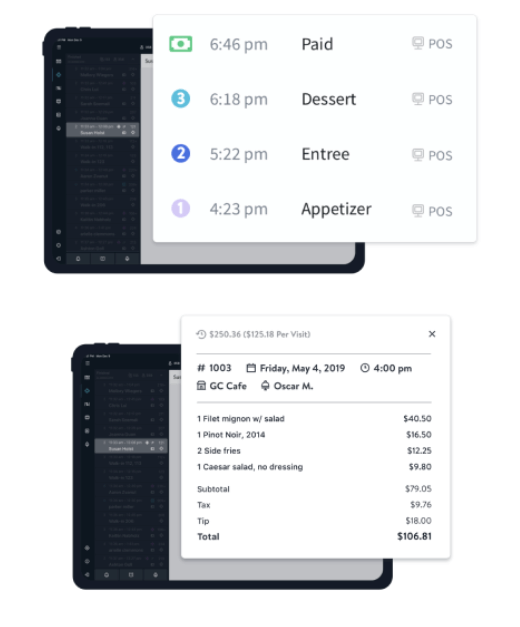
Resy was “built by restaurants for restaurants.” It’s a cloud-based system. Updates are made in real time and it’s priced according to a variety of monthly plans. Over the last decade, the ResyOS system has become known among restaurant owners and managers for its functionality and flexibility.
Zenchef is a leader in independent online booking solutions. Independence here is key: Zenchef doesn’t charge commissions on bookings. In addition, customer data belongs solely to the restaurant. The platform also allows users to centralize bookings from different online portals. It’s currently used by over 8,000 restaurants.
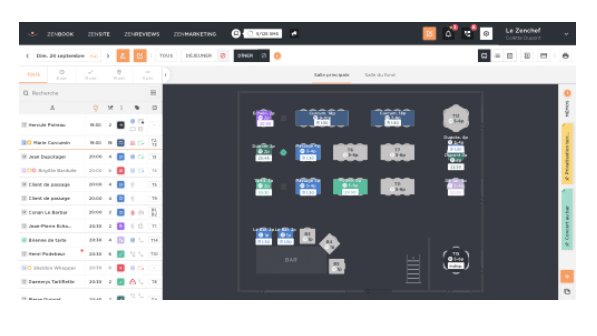
Founded in 2015, CoverManager is an online reservation system that doesn’t charge a booking commission per seat. It also allows restaurants to book through direct channels (website, phone and social media pages).
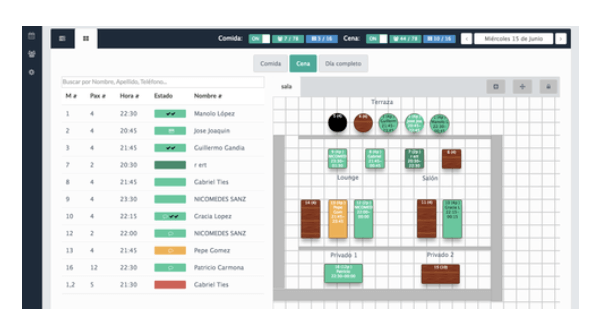
Drive online restaurant reservations through social media
You’ve found your online reservation software. Now it’s time to put it to work for you.
By creating business pages for your Meta accounts—Facebook and Instagram—you’ve taken the first step in being able to capture online reservations. It’s an important part of your restaurant marketing strategy.
Next, give guests a chance to book directly with your restaurant by adding a reservation widget across your social channels. You can opt to use Meta’s “Book Now” feature. Or you can link your restaurant reservation software to your pages. Find out more about the Book Now tool and the different reservations that link to your social platforms on Meta’s website.
Don’t forget about TikTok
TikTok is quickly gaining ground as a search engine—particularly among younger users.
Gen Z and Millennials often turn to TikTok to decide where to eat. Many younger users use the app to find local restaurants. A recent survey showed that over half of users between the ages of 26 and 41 ordered from a restaurant they saw on TikTok.
You can advertise on TikTok or use the app to make short videos that showcase the different things that make your restaurant special.
Sounds too labor intensive? Pick a hashtag and encourage guests to use it in the short videos they make or pictures they take in your restaurant. Find out more about how to leverage their content in our blog post about making the most out of user-generated content here.
A note on third-party reservations
Note that if you use a third-party reservation widget on your socials, you might be unable to optimize their value because you might not be able to access your guest data. This can prevent you from offering patrons truly memorable experiences.
On top of that, you’re likely also paying acquisition costs for each reservation—even though guests are finding you directly. This adds up over time and is easily preventable!
Once your social media channels are ready, it’s time to promote your restaurant. You can do this in two ways: organic and paid socials.
Organic social
Organic social is, essentially, free. It involves building a community by sharing posts and responding to comments.
Organic social media posts mostly reach existing guests and followers. Your content should be authentic and aligned with your brand.
The rule of thirds is a good strategy for organic social media posts. Aim for one third of each:
- Sales posts
- User-generated posts
- Brand posts
Sales posts
Are you selling tickets to a special dinner? Or want to include a box of pastries as an upsell for Mother’s Day? Just want to drive more reservations? These are sales posts. They’re created to drive more direct business to your restaurant.
User-generated posts
User-generated posts let you engage with your community. Sharing photos taken by your guests shows that you care about their experiences. It also highlights the unforgettable times guests will have at your restaurant, which builds brand loyalty.
Brand posts
Brand posts should directly reflect your unique brand, property and staff. A fun photo of a waiter showing off your latest burger creation or a behind-the-scenes shot of your chef in action during service—these posts show off what makes your restaurant unique.
Paid Social
Paid social is when you pay to display advertisements (whatever the format—text, image, video, carousel, etc.) or sponsored messages to social network users based on their user profile. You pay based on the type of ads you use.
Global social media advertising spending is estimated to reach a whopping $262 billion by 2028. With social media’s rise, organic reach isn’t what it used to be. A paid social strategy can bridge the gap.
But the biggest challenge is in 1) how to set up paid social 2) knowing how much to spend, and 3) figuring out what to share.
Setting up Facebook and Instagram ads
The first step to any campaign is getting Meta’s Ads Manager set up for your business page. This allows you to test, create, manage and track any ads you decide to run on Facebook, Instagram, Messenger or Audience Network.
And with the Ads Manager app for iOS and Android, you can manage your ads anytime, from anywhere. Find out more on Meta’s website, which includes step-by-step instructions on how to begin.
Once you push your ads live, you’re on your way to getting more reservations for your business.
Sharing paid social
One of the easiest ways to get more for your money on social media is to promote existing posts. It takes less than a minute to set up. Make sure your social accounts are set up as ‘business’ pages and simply go through the flows to push your promotion live.
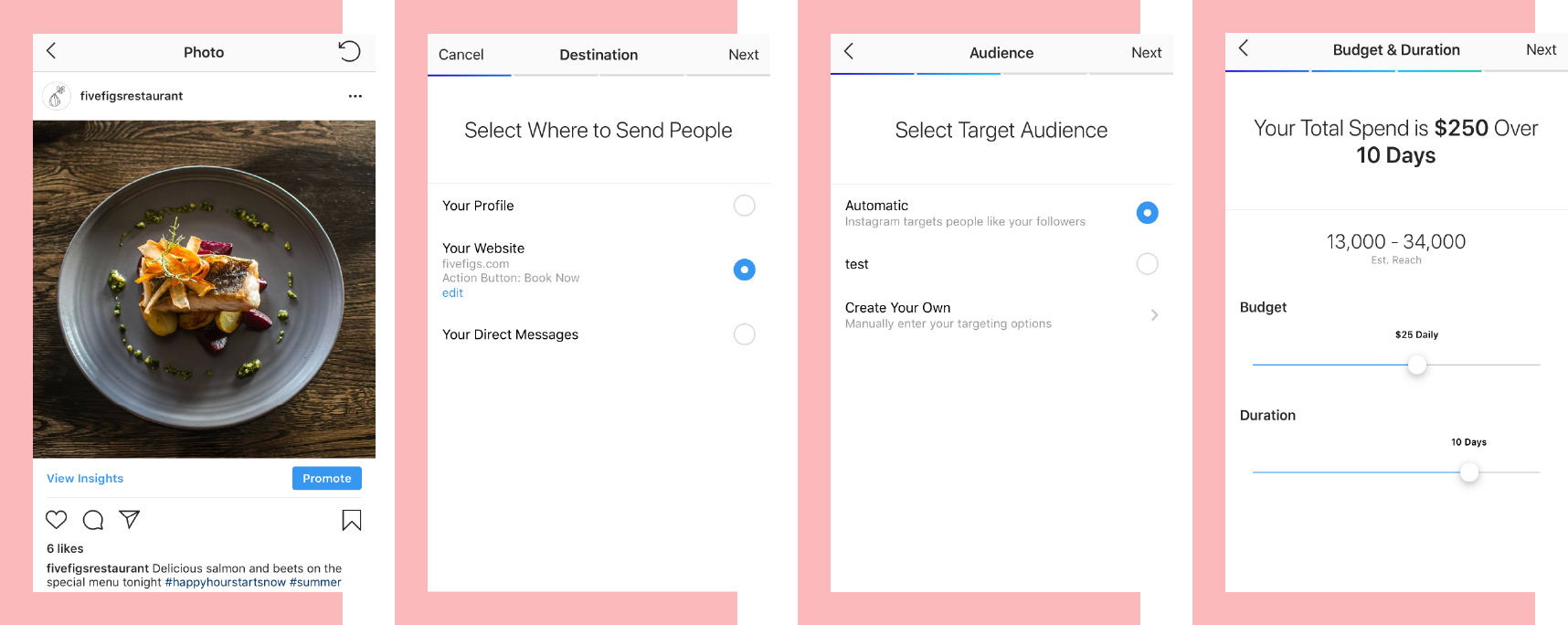
Next, it’s time to boost your post to increase the number of Facebook and Instagram users that will see it.
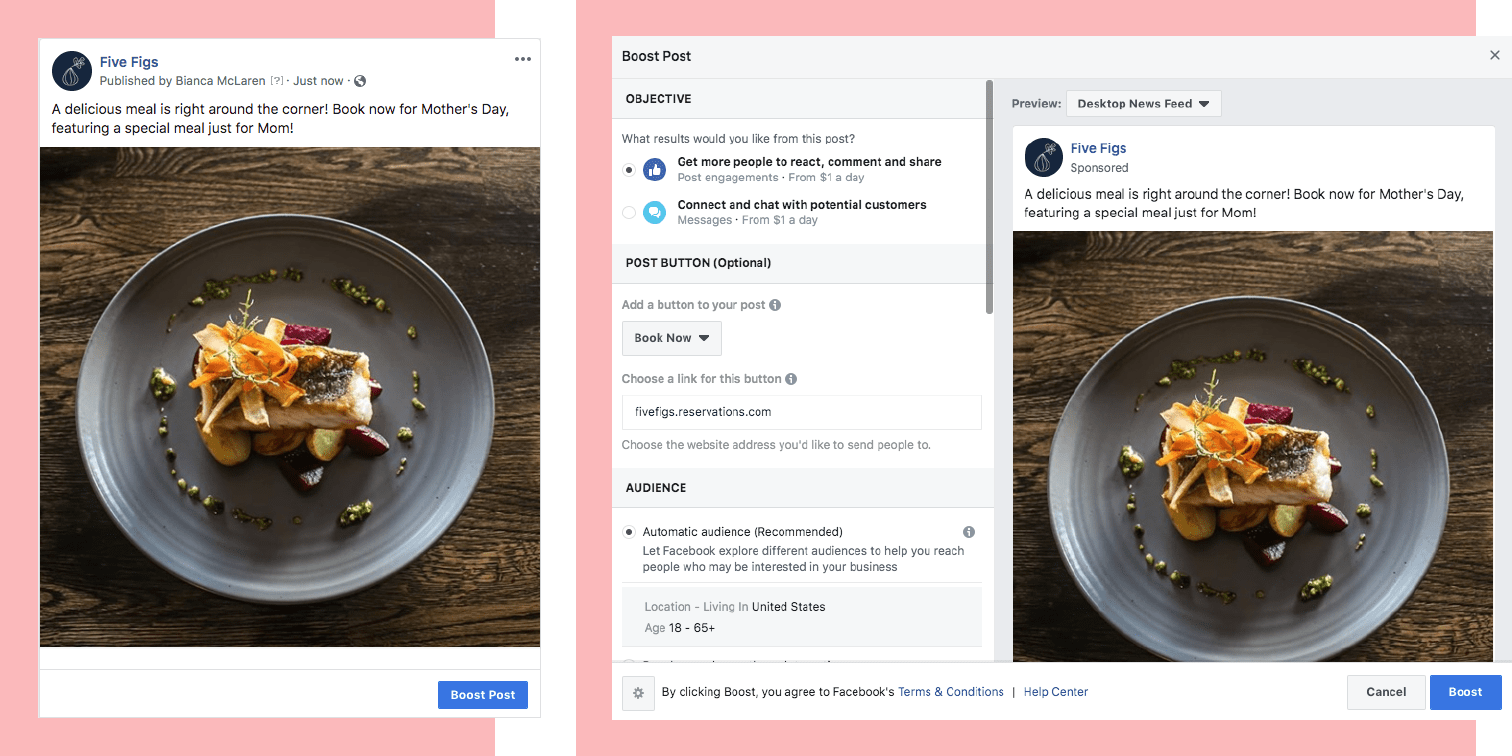
Drive online reservations through Google Search
Google’s value in driving more direct reservations can’t be ignored.
Up to 30% of SevenRooms clients’ reservations are booked through Google—a steadily growing number, as consumers continue to use Google Search to find and book restaurant reservations.
Google Business Profile
A Google Business profile lets you show important information about your restaurant in a “knowledge panel” that shows up on Google Search and Maps. The knowledge panel includes your business’s address, hours, phone number, reviews and call to action buttons for ordering delivery or booking a reservation.
This is where your choice of online reservation software comes back into play. Be sure that:
- Your reservation software integrates with Google. As it handles over 90% of global Internet searches, Google is an indispensable acquisition channel.
- You can track which reservations come through Google.
Many third-party booking systems charge cover fees for bookings made through Google but don’t share important guest information. Your reservation partner should tell you which booking was made on Google and allow you to own 100% of your guest data—including email addresses, phone numbers and more.
Here are a few things to think about as you build out your Google Business listing:
- Download the Google My Business app to make quick changes on the go
- Add photos to your listing to display your brand, food and restaurant
- Respond to all reviews—yes, even the negative ones—as this can be a big driver for return visits
- Customize your reservation link with a tracking parameter to know which reservations are coming through Google
- Edit your one-sentence description for guests who want to know more about your restaurant
- Ensure all your restaurant information is correct—from phone number and address to hours of operation—so guests know exactly how to reach and visit you
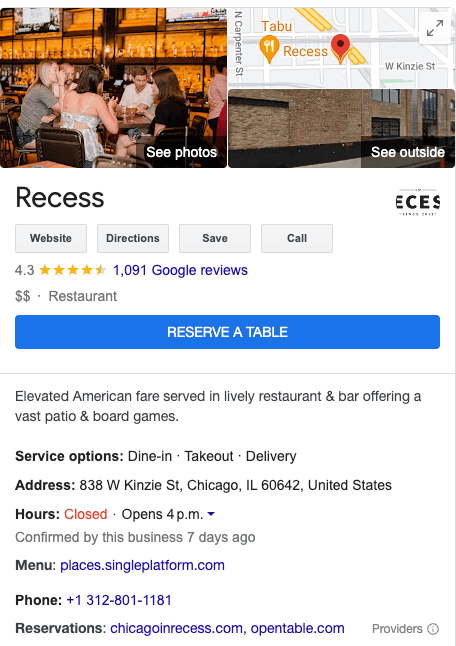
Improve your SEO rankings
Search Engine Optimization (SEO) is the practice of increasing the quantity and quality of traffic to your website through organic search engine results. Moz’s Hierarchy of SEO Needs illustrates how Google rankings work and what you can do to rank higher on the Google search results page, more often.
For your website, it’s most important to remember:
- Crawl accessibility (e.g. how easy it is for Google to access information on your website)
- Compelling content (e.g. how closely your content addresses a search query)
- Keyword optimization (e.g. content that is keyword loaded and ties back to your restaurant—for example, “Italian restaurant Manhattan”)
- Great user experience (e.g. a website that’s fast, mobile-friendly, and easy to use)
- Share-worthy content (e.g. more people referencing back to your website in their content—like Eater or other similar pages including a link back to your website in a story about your restaurant)
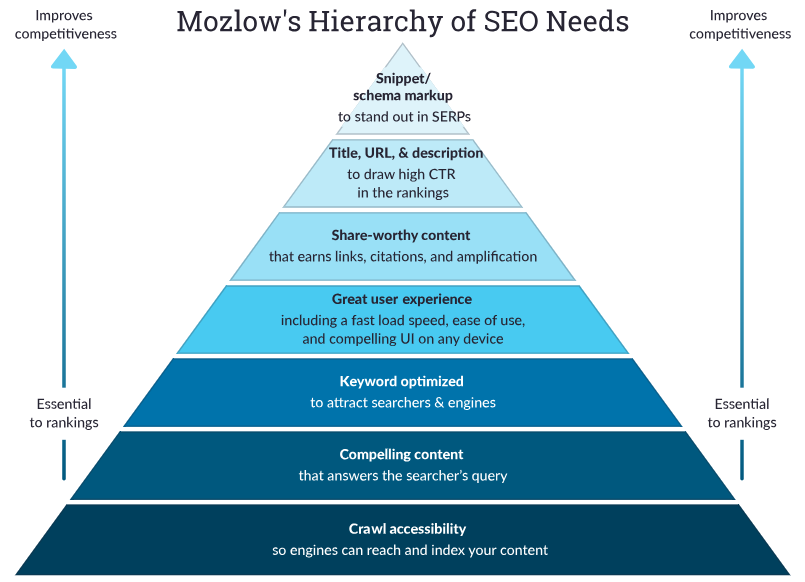
Image source: Moz.com
A robust digital strategy can improve SEO. Work with your in-house marketing and PR team or an external agency to ensure you have a mobile-friendly, easy-to-use website. This should include multiple pages that address key aspects of your restaurant (e.g. About, Menu, Reservations, Contact, Press, Delivery, Private Events, and Catering), and keyword-focused content and posts about your company.
Branded vs. non-branded Google Ads
Search Engine Marketing (SEM) is a type of paid online marketing associated with buying traffic through search engines to increase traffic and visibility. The easiest and fastest way to do this is by creating Google Ads.
With an estimated 3.5 billion searches performed on Google every day, Google Search Ads are a great way to get your restaurant in front of new guests to help fill seats. However, a Pay Per Click (PPC) model can make these ads expensive, especially if you’re competing for branded keywords vs. non-branded keywords.
Branded keywords
Branded keywords are any words or phrases that directly mention your restaurant or brand name. These could include:
- [Your restaurant name] reservations
- [Your restaurant name] NYC
- [Your restaurant name] menu
- [Your restaurant name] hours
- [Your restaurant name] brunch
- [Your restaurant name] delivery
- [Your restaurant name] catering
- [Your restaurant name] private events
- [Your restaurant name] address
- [Your restaurant name] phone number

Branded keywords are typically the cheaper of the two keyword options. You’ll compete with a much smaller audience to take the top ‘ad’ spot at the top of Google Search. Plus, these branded terms capture guests who are at the bottom of the funnel and close to converting. In other words, those who want to book a reservation ASAP.
Non-branded keywords
Non-branded keywords are “any keywords that do not reference a brand name or any part of it.” These could include:
- Italian restaurant
- Calzone NYC
- Spaghetti near Times Square
- Best pasta Chelsea
- Michelin star dining NYC
- Best NYC restaurants
- Cacio e pepe Manhattan

Non-branded keywords capture a guest in the search and discovery phase. These guests might have never heard of your restaurant. That being said, they’re looking for a venue that aligns with their search (for example, best pasta in NYC). Non-branded Google Search ads can get very expensive. There will be much more competition on the word or phrase.
To put it another way, the phrase “best pasta in NYC” could compete with over 1,000 restaurants for the top ad spot!
Finally, remember to align your message and search terms with your audience. It probably doesn’t make sense for an NYC-based restaurant to be creating campaigns in Hong Kong, or for a French bistro to target taco-seeking diners in their search terms.
Making the most of online reservations
The pandemic’s effects on the hospitality industry are still keenly felt. Supply chain disruptions, staffing shortages and price increases are just some of the main challenges facing restaurant owners today.
Attract new customers with special offers
A recent industry report by Deloitte found that consumers still want to enjoy dining out despite shrinking household budgets. Guests are looking for great value like promotional offers and discounts.
If your restaurant reservation system allows you to collect consumer data, you can use this knowledge to develop targeted special menu items at reduced prices to ensure repeat visits.
Consider a no-show charge
Altered consumer behavior is another issue in a post-pandemic reality.
When restaurants reopened after COVID-19 lockdowns, bookings were mandatory and difficult to come by. Some diners got into the habit of booking multiple options, only to cancel all but one at the last minute—or worse, just never show up. According to Carbon Free Dining, up to 20% of diners in large cities simply don’t turn up.
A restaurant reservation system can help reduce no-shows and late cancellations by issuing reminders. Still, some of the world’s top restaurants now charge a fee to clients who either cancel on too short notice or don’t turn up.
It’s a delicate balance. Charging a no-show or a cancellation fee can reduce the cost burden associated with empty tables that were meant to be filled. However, it can also deter some guests from making a reservation in the first place.
That’s a wrap
Each of these marketing tools can be extremely powerful. However, it all starts with having the right online reservation system.
With the right technology in place, you can drive more traffic through social media, take your Google Search Ads to another level and collect valuable customer data from booking to bill.
Ready to take your restaurant to the next level? Find out more about Lightspeed’s unified point of sale and payments platform on our website.

News you care about. Tips you can use.
Everything your business needs to grow, delivered straight to your inbox.


